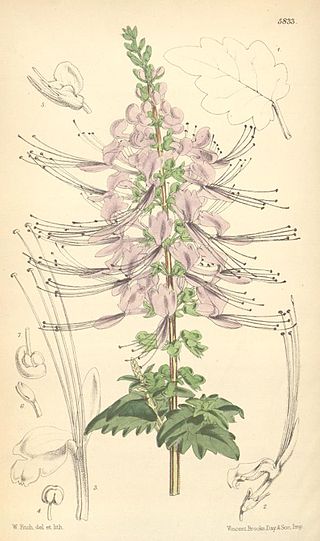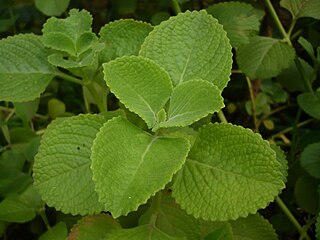
Solenostemon is a former genus of flowering plants in the family Lamiaceae. It has been included in the genus Plectranthus, but is now included in an expanded Coleus. They are native to tropical Africa, Asia and Australia. Some species formerly placed in this genus are cultivated for their highly variegated leaves.

Ocimum is a genus of aromatic annual and perennial herbs and shrubs in the family Lamiaceae, native to the tropical and warm temperate regions of all 6 inhabited continents, with the greatest number of species in Africa. It is the genus of basil and its best known species are the cooking herb great basil, O. basilicum, and the medicinal herb tulsi, O. tenuiflorum.

Plectranthus is a genus of about 85 species of flowering plants from the sage family, Lamiaceae, found mostly in southern and tropical Africa and Madagascar. Common names include spur-flower. Plectranthus species are herbaceous perennial plants, rarely annuals or soft-wooded shrubs, sometimes succulent; sometimes with a tuberous base.

Orthosiphon is a genus of plants in the family Lamiaceae native to Africa, Southern Asia and Queensland, with one species (O. americanus) in Colombia. They are herbaceous shrubs which grow to a height of 1.5 m (5 ft). Some Orthosiphon species are popular garden plants because of their flowers, which are white and bluish with filaments resembling a cat's whiskers. In the wild, the plants can be seen growing in forests and along roadsides.

Coleus caninus, synonym Plectranthus caninus, is a herb from the mint family Lamiaceae, native to southern and eastern Africa from Angola to Sudan and to India and Myanmar.

Coleus scutellarioides, commonly known as coleus, is a species of flowering plant in the family Lamiaceae, native to southeast Asia through to Australia. Typically growing to 60–75 cm (24–30 in) tall and wide, it is a bushy, woody-based evergreen perennial, widely grown for the highly decorative variegated leaves found in cultivated varieties. Another common name is painted nettle, reflecting its relationship to deadnettles, which are in the same family. The synonyms Coleus blumei, Plectranthus scutellarioides and Solenostemon scutellarioides are also widely used for this species.

Coleus is a genus of annual or perennial herbs or shrubs, sometimes succulent, sometimes with a fleshy or tuberous rootstock, found in the Afro-Eurasia tropics and subtropics.

Tinnea (sunbells) is a genus of plants in the family Lamiaceae first described in 1867. It is native to sub-Saharan Africa. It was named in honour of the Dutch explorer Alexine Tinne.
- Tinnea aethiopicaKotschy ex Hook.f. - widespread from Mali to Somalia south to Mozambique; naturalized in Trinidad & Tobago
- Tinnea antiscorbuticaWelw. - DRC, Zambia, Angola
- Tinnea apiculataRobyns & Lebrun - eastern Africa from Rwanda to Mozambique
- Tinnea barbataVollesen - Eswatini, northern South Africa
- Tinnea barteriGürke - western Africa
- Tinnea benguellensisGürke - Angola
- Tinnea coeruleaGürke - DRC, Zambia, Angola
- Tinnea eriocalyxWelw. - DRC, Angola, Botswana, Namibia
- Tinnea galpiniiBriq. - Eswatini, Mozambique, South Africa
- Tinnea gossweileriRobyns & Lebrun - Angola
- Tinnea gracilisGürke - Tanzania to Zambia
- Tinnea mirabilis(Bullock) Vollesen - Tanzania
- Tinnea physalisE.A.Bruce - Tanzania
- Tinnea platyphyllaBriq. - DRC
- Tinnea rhodesianaS.Moore - South Africa, Namibia, Zimbabwe, Zambia, Angola, Mozambique
- Tinnea somalensisGürke ex Chiov. - Ethiopia
- Tinnea vesiculosaGürke - Tanzania, Malawi
- Tinnea vestitaBaker - Zimbabwe, Zambia, Angola, Botswana
- Tinnea zambesiacaBaker - Zimbabwe, Zambia, Malawi, Mozambique

Aeollanthus (rocksage) is a genus in the mint family, Lamiaceae. All the species are native to Africa.

Capitanopsis is a genus of plants in the family Lamiaceae, first described in 1916. It contains six known species, all endemic to Madagascar.
Endostemon (keepsafe) is a genus of plants in the family Lamiaceae, first described in 1910. It is native primarily to eastern Africa, with some species in central and southern Africa, the Arabian Peninsula, Madagascar, and the Indian subcontinent.
- Endostemon albusA.J.Paton, Harley & M.M.Harley - Kenya, Tanzania, Mozambique
- Endostemon camporum(Gürke) M.R.Ashby - Kenya, Tanzania
- Endostemon ctenoneurusHarley - Kenya, Somalia
- Endostemon glandulosusHarley & Sebsebe - Ethiopia
- Endostemon gracilis(Benth.) M.R.Ashby - Kenya, Somalia, Tanzania, Yemen
- Endostemon kelleri(Briq.) Ryding ex A.J.Paton & Harley - Kenya, Somalia, Ethiopia
- Endostemon leucosphaerus(Briq.) A.J.Paton, Harley & M.M.Harley - Somalia, Ethiopia
- Endostemon membranaceus(Benth.) Ayob. ex A.J.Paton & Harley - Cameroon, Angola, Central African Republic
- Endostemon obbiadensis(Chiov.) M.R.Ashby - Somalia
- Endostemon obtusifolius(E.Mey.) N.E.Br. - from South Africa north to Angola and Tanzania
- Endostemon racemosusRyding, A.J.Paton & Thulin - Somalia
- Endostemon stenocaulis(Hedge) Ryding, A.J.Paton & Thulin - Somalia
- Endostemon tenuiflorus(Benth.) M.R.Ashby - eastern + southern Africa, Madagascar, Arabian Peninsula
- Endostemon tereticaulis(Poir.) M.R.Ashby - widespread across much of tropical Africa, also Yemen + Saudi Arabia
- Endostemon tomentosusHarley & Sebsebe - Somalia
- Endostemon tubulascens(Briq.) M.R.Ashby - Angola
- Endostemon usambarensisM.R.Ashby - Tanzania
- Endostemon villosus(Briq.) M.R.Ashby - central Africa
- Endostemon viscosus(Roth) M.R.Ashby - India, Assam, Sri Lanka
- Endostemon wakefieldii(Baker) M.R.Ashby - Kenya

Haumaniastrum is a genus of flowering plants in the mint family, Lamiaceae, first described in 1959. The species are native to Africa.

Pycnostachys is a genus of plants in the family Lamiaceae, first described in 1826. It is native to sub-Saharan Africa including Madagascar.
- Pycnostachys abyssinicaFresen. - Ethiopia
- Pycnostachys angolensisG.Taylor - Angola
- Pycnostachys batesiiBaker - Cameroon, Zaïre, Sudan, Uganda
- Pycnostachys chevalieriBriq. - Central African Republic
- Pycnostachys ciliataBramley - Tanzania, Malawi, Mozambique, Zambia
- Pycnostachys coeruleaHook. - East Africa from Ethiopia to Botswana; Madagascar
- Pycnostachys congensisGürke - Zaïre, Zambia
- Pycnostachys de-wildemanianaRobyns & Lebrun - East Africa from Burundi to Zimbabwe
- Pycnostachys deflexifoliaBaker - Kenya, Tanzania, Uganda
- Pycnostachys descampsiiBriq. - Zaïre
- Pycnostachys elliotiiS.Moore - Zaïre, Uganda
- Pycnostachys eminiiGürke - from Cameroon to Ethiopia + Tanzania
- Pycnostachys erici-roseniiR.E.Fr - Zaïre, Uganda, Burundi, Rwanda
- Pycnostachys goetzeniiGürke - Zaïre, Uganda, Rwanda
- Pycnostachys gracilisR.D.Good - Angola
- Pycnostachys graminifoliaPerkins - Tanzania
- Pycnostachys kassneriDe Wild - Zaïre, Zambia, Tanzania
- Pycnostachys lancifoliaBramley - Tanzania
- Pycnostachys meyeriGürke - western + central Africa
- Pycnostachys nepetifoliaBaker - Kenya
- Pycnostachys niamniamensisGürke - South Sudan, Kenya, Uganda
- Pycnostachys orthodontaGürke - Zimbabwe, Mozambique, Zambia, Tanzania
- Pycnostachys parvifoliaBaker - Zambia, Tanzania, Malawi
- Pycnostachys prittwitziiPerkins - Zambia, Tanzania
- Pycnostachys pseudospeciosaBuscal. & Muschl. - Zaïre, Zambia
- Pycnostachys recurvataRyding - Ethiopia
- Pycnostachys reticulata(E.Mey.) Benth. - central + southern Africa
- Pycnostachys ruandensisDe Wild. - east-central Africa
- Pycnostachys schliebeniiMildbr. - east-central Africa
- Pycnostachys schweinfurthiiBriq - western + central Africa
- Pycnostachys speciosaGürke - Kenya, Uganda, Tanzania, Rwanda
- Pycnostachys sphaerocephalaBaker - Zambia, Tanzania, Malawi, Zaïre
- Pycnostachys stuhlmanniiGürke - central Africa
- Pycnostachys umbrosa(Vatke) Perkins - Kenya, Tanzania
- Pycnostachys urticifoliaHook. - southeastern Africa
- Pycnostachys verticillataBaker - Zambia, Tanzania

Syncolostemon (sagebushes) is a genus of plants in the family Lamiaceae, first described in 1838. It is native primarily to South Africa, with some species in other parts of sub-Saharan Africa, plus one species in India.
- Syncolostemon albiflorus(N.E.Br.) D.F.Otieno - Transvaal, Eswatini
- Syncolostemon argenteusN.E.Br. - KwaZulu-Natal
- Syncolostemon bolusii(N.E.Br.) D.F.Otieno - KwaZulu-Natal
- Syncolostemon bracteosus(Benth.) D.F.Otieno - widespread across much of sub-Saharan Africa
- Syncolostemon canescens(Gürke) D.F.Otieno - Angola, Botswana, Zimbabwe, Eswatini, South Africa
- Syncolostemon cinereum(Codd) D.F.Otieno & Retief - South Africa
- Syncolostemon comosus(Wight ex Benth.) D.F.Otieno - southern India
- Syncolostemon comptoniiCodd - Eswatini
- Syncolostemon concinnusN.E.Br. - Eswatini, South Africa
- Syncolostemon densiflorusBenth. - South Africa
- Syncolostemon elliottii(Baker) D.F.Otieno - Zimbabwe, Botswana, Transvaal
- Syncolostemon eriocephalusVerd. - Northern Province of South Africa
- Syncolostemon flabellifolius(S.Moore) A.J.Paton - Chimanimani Mountains of Mozambique + Zimbabwe
- Syncolostemon floccosus(Launert) D.F.Otieno - Namibia
- Syncolostemon foliosus(S.Moore) D.F.Otieno - Eswatini, South Africa
- Syncolostemon gerrardii(N.E.Br.) D.F.Otieno - South Africa
- Syncolostemon incanus(Codd) D.F.Otieno - Northern Province of South Africa
- Syncolostemon latidens(N.E.Br.) Codd - KwaZulu-Natal
- Syncolostemon linearis(Benth.) D.F.Otieno - Zimbabwe
- Syncolostemon macranthus(Gürke) Ashby - Drakensberg Mountains in South Africa
- Syncolostemon macrophyllusGürke - South Africa
- Syncolostemon madagascariensis(A.J.Paton & Hedge) D.F.Otieno - Madagascar
- Syncolostemon modestus(Codd) D.F.Otieno - Eswatini, South Africa
- Syncolostemon namapaensisD.F.Otieno - Mozambique, Tanzania
- Syncolostemon obermeyerae(M.Ashby) D.F.Otieno - Northern Province of South Africa
- Syncolostemon oritrephes(Wild) D.F.Otieno - Chimanimani Mountains of Mozambique + Zimbabwe
- Syncolostemon ornatus(S.Moore) D.F.Otieno - Chimanimani Mountains of Zimbabwe
- Syncolostemon parviflorusE.Mey. ex Benth. - Eswatini, South Africa
- Syncolostemon parvifolius(Codd) D.F.Otieno - Northern Province of South Africa
- Syncolostemon persimilis(N.E.Br.) D.F.Otieno - Northern Province of South Africa
- Syncolostemon petiolatus(Ashby) D.F.Otieno - Eswatini, South Africa, Mozambique
- Syncolostemon pretoriae(Gürke) D.F.Otieno - Eswatini, South Africa
- Syncolostemon punctatus(Codd) D.F.Otieno - Northern Province of South Africa
- Syncolostemon ramosus(Codd) D.F.Otieno - KwaZulu-Natal
- Syncolostemon ramulosusE.Mey. ex Benth. - KwaZulu-Natal, Cape Province
- Syncolostemon rehmannii(Gürke) D.F.Otieno - Northern Province of South Africa
- Syncolostemon rotundifoliusE.Mey. ex Benth. - KwaZulu-Natal, Cape Province
- Syncolostemon rugosifolius(M.Ashby) D.F.Otieno - Northern Province of South Africa
- Syncolostemon stalmansii(A.J.Paton & K.Balkwill) D.F.Otieno - Mpumalanga, Eswatini
- Syncolostemon stenophyllus(Gürke) D.F.Otieno - KwaZulu-Natal, Cape Province
- Syncolostemon subvelutinus(Gürke) D.F.Otieno - Northern Province of South Africa
- Syncolostemon teucriifolius(Hochst.) D.F.Otieno - Mozambique, Zimbabwe, South Africa
- Syncolostemon thorncroftii(N.E.Br.) D.F.Otieno - Northern Province of South Africa
- Syncolostemon transvaalensis(Schltr.) D.F.Otieno - Northern Province of South Africa
- Syncolostemon welwitschii(Rolfe) D.F.Otieno - Nigeria, Cameroon, Central African Republic, Zaire, Tanzania, Zambia, Angola
Coleus maculosus is a species of flowering plant in the family Lamiaceae. It is widespread in tropical Africa and Madagascar.

Coleus comosus, synonym Plectranthus ornatus, is a flowering plant from the mint family Lamiaceae, native to eastern Africa.

Capitanopsis brevilabra is a species of flowering plant in the family Lamiaceae. It is an herb or shrub native to southeastern Madagascar. It flowers in March.
Capitanopsis oreophila, synonym Plectranthus bipinnatus, is a species of flowering plant in the family Lamiaceae. It is a small shrub native to Madagascar, where it is commonly known as andriamborondrao.













